The Penobscot 14 is a versatile sail, oar, and motor boat designed by Arch Davis in the early ’90s. His goal was to design a boat that was easy to build, had pleasing lines, and offered excellent sailing and rowing performance. He did not take inspiration from any particular existing design, and says his design was “based on many years of looking at boats and trying to figure out what makes a good one.”
He was influenced a bit by the Whitehall-type boats, but most have a narrow beam in proportion to their length and rarely a sailing rig, so Davis gave the hull more bearing to enable it carry sail and drew three sail plans—gunter sloop, lug cat, and sprit cat—to meet a variety of needs. Arch built the first Penobscot 14 in 1992, and the result was a seakindly hull with striking lines. Hull No. 1 sits in his garage, not taking up much space, and he still takes it out to row. He published plans in 1993 and since then has sold over 1,500 sets of them.
 Kent Lewis
Kent LewisThe stringers that back up the laps strengthen the hull without the need for frames.
The glued-lapstrake 14′ plywood hull has an innovative structure with wider, and therefore fewer, planks, simplifying construction. The internal framework of longitudinal stringers is anchored to the stem, two bulkheads, and the transom. Two temporary molds help fair the stringers while the six strakes are applied. These stringers provide exceptional strength along the plank laps. The planks are attached to the stringers with glue and stainless-steel screws, and so fewer clamps are required.
Woodworkers with some experience can turn themselves into boatbuilders by following Davis’s excellent study package and watching the companion DVD. There are several helpful offerings to choose from: a 14-page set of plans; an illustrated 74-page builder’s guide; full-sized Mylar patterns for bulkheads, stem, transom and molds; and a frame kit, which includes bulkheads, temporary building frames, and transom frame. Kits for the sails, spars, and rigging are also available. If a builder needs help along the way, Davis responds to phone calls and emails; he was a big help to us during the construction of our P14.
 Kaitlynn Lewis
Kaitlynn LewisThe authors, here aboard their Penobscot 14, ST. JACQUES, opted for the sprit rig. The brail, clearly visible here against the tanbark cloth, makes quick work of gathering up the loose-footed sail.
Construction begins with the assembly of a jig built of common lumber. Davis emphasizes that a variety of materials may be used during all phases of construction, and recommends taking advantage of locally available materials. The boat is built upside down both on the temporary molds and what will become the bulkheads, stem, and transom. We chose okoume plywood planking, cypress stringers, and a white oak keel.
The keel can be built with a slot for a daggerboard or a centerboard, or left solid if the boat is intended solely for rowing. After the stringers and sheer clamp are added, planking begins from the garboard. When the deadwood is attached and the planking is complete, the boat is flipped right-side up, and it’s time to add the centerboard or daggerboard trunk. The bulkheads are meant to enclose watertight flotation compartments in each end, but we varied from plan and opted for readily compartments under the bow and stern seats and use spare PFDs as flotation in them. The breasthook, quarter knees, gunwale, and railcap complete construction of the hull.
In the three rigs Davis provides in the plans, the lug rig carries 77 sq ft of sail, the sprit rig 73, and gunter rig 95. The spars for all of the rigs will fit inside the hull when not in use. We chose the small sprit rig for ease of rigging and handling on our gusty bay.
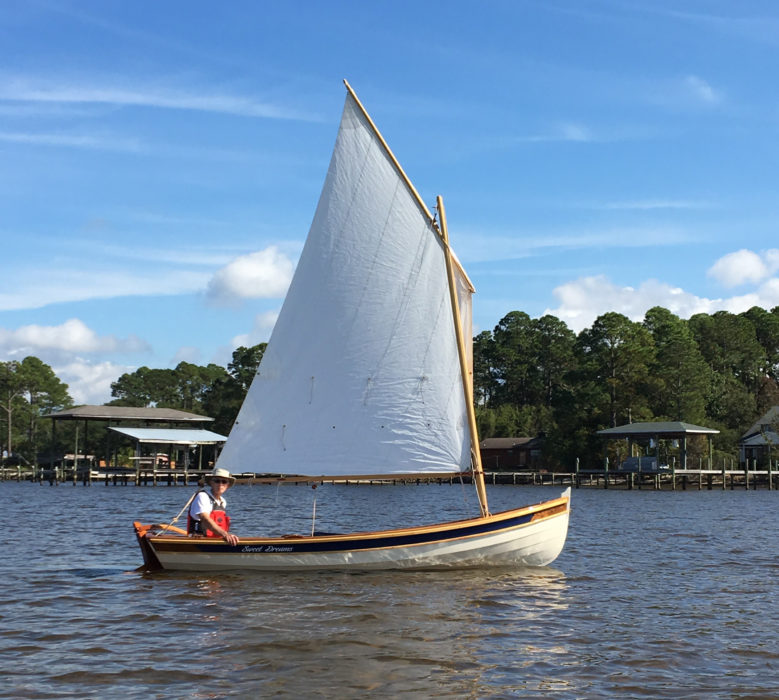 Audrey Lewis
Audrey LewisJohn Stevenson’s SWEET DREAMS carries the boomed standing lug.
The boat is lightweight, easy to trailer, and getting underway is simple: Step the mast, bend on sail, and ship the rudder. At our beachfront home we launch with a dolly and further afield the boat is light enough to launch easily via trailer on a ramp. We can be underway in about 20 minutes. We wade the boat out a few feet and climb aboard over the side. Davis says that he boards over the transom, then pushes the rudder down with the trailing foot as he gets underway.
Once onboard we drop the centerboard a bit, row a few feet to get deep enough to drop the rudder blade, and look for the wind. When we find it, we loosen the brail and the sprit sets nicely. The sprit’s snotter runs down to the mast thwart and is tied off to a belaying pin. We use another pin for the brail. The sheets are easy to reach and to route aft for singlehanding.
The Penobscot 14 is a stable sailer, well suited for skinny water, and very comfortable for the crew with plenty of room for camp-cruising gear. With the sprit rig, heeling is minimal, and the boat exceeds 3 knots with little effort when we are out messing about. It will not point especially high; its favorite point of sail is a beam reach. The hull has just the right enough of keel and deadwood to sail in shallow water with the rudder retracted and the centerboard up.
The arrangement of the sides and seat offer many convenient places to sit with comfortable back support. The skipper’s favorite position is reclined against the transom with her foot up on a side seat. The stringers act as “mini shelves” that can hold gear such as a boathook, a paddle, or coffee cups. A small section of floorboards may be added, but we left the bilge open so we can see where all the spilled coffee went.
 Audrey Lewis
Audrey LewisThe Penobscot 14 rows with ease, carries well, and tracks straight. Davis recommends 8′ oars. With the two rowing stations the boat can be rowed tandem.
When we can’t find the wind, there are rowing stations forward and amidships. There is plenty of room to row from either station, and the boat is well balanced with our crew of two—skipper on the aft seat and the first mate taking his place amidships or forward. The Penobscot 14 rows with ease, carries well, and tracks well. The oars may be left in the oarlocks when not in use, with the blades tucked neatly under the breasthook. There is also sufficient room to lay them on the side seats. Our neighbor has built two Penobscot 14s and has rowed them over 1,200 miles, so it is safe to say that it is good rowboat.

There’s a notch in the transom for those who have a knack for sculling, and, if motoring appeals, the plans included instructions for equipping the boat with a small outboard of 2 to 3 hp.
The plans for the Penobscot 14 have provisions for mounting a small outboard. In this case, the transom is made thicker and a small, removable section is cut to accommodate a short-shaft motor. If the motor is not permanently mounted, the section that has been cut out is designed to be dropped back into place to restore the appearance of the transom.
The Penobscot 14 is easy to care for and store. After a day on the water, it is a simple task to wipe down the hull and cockpit by sponging the water (and coffee) out from easy-to-reach low points. The spars, sail, and rudder stow in the hull, then we throw on a custom-made Sunbrella cover.
The Penobscot 14 performs well as-designed and is delightful. We highly recommend it to anyone looking to build a boat with a few attractive curves and a versatile rig for messing about. There is great support community for owners of Penobscot 14s as well. We can confirm what Davis has to say about the boat: “The attention she draws wherever you take her, and her excellent performance under sail or oars, will give you great enjoyment for years to come.”![]()
Audrey and Kent Lewis live in Florida and enjoy small-boat sailing, restoration and boatbuilding when she’s not designing costumes or he’s flying. They launched their Penobscot 14 in 2017, and in 2016 they restored an 1880s Mississippi River Skiff for the Beauvoir Museum in Biloxi, Mississippi. Their personal fleet includes several Sunfish, a wooden Sailfish, wooden Sunfish, Catfish catamaran, O’Day Daysailer, Drascombe Lugger, and Drascombe Dabber. They have also rescued and fostered over 30 boats since 2011. Some people describe them as “boat-struck.” They document their boating pursuits in their blog.
Penobscot 14 Particulars
[table]
Length/14′
Waterline length/12′ 8″
Beam/ 4′ 6.5″
Draft, board up/ 7″
Draft, down/ 2′ 6″
Weight/155–175 lbs
[/table]
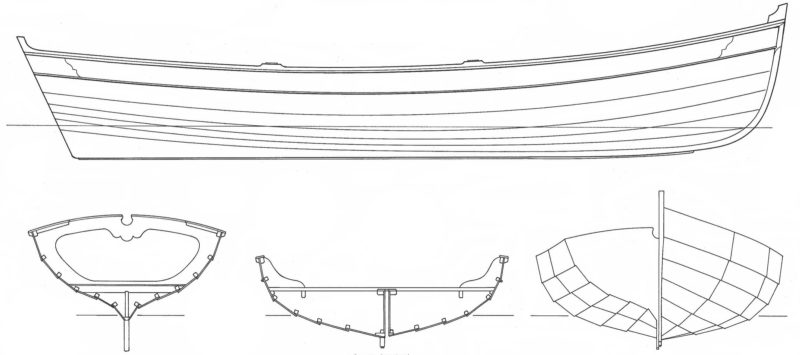




Plans for the Penobscot 14 are available from Arch Davis Designs: Study Package (covers Penobscot 13, 14, and 17), $15; Boat Plans, $125; Frame Kit, $850. Inquire for details on other kits. WoodenBoat chronicled the construction of the Penobscot 14 in Nos. 138, 139, and 140.
Is there a boat you’d like to know more about? Have you built one that you think other Small Boats Monthly readers would enjoy? Please email us!

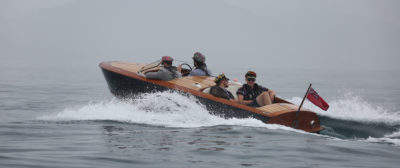







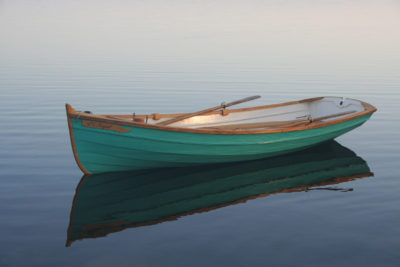
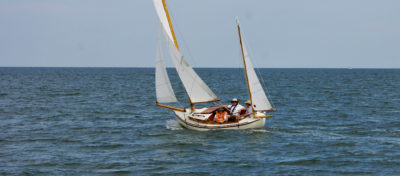












Nice little boat for one-man use
It is great for rowing; our friend has built two for that purpose. He lost the first one in Hurricane Ivan. And there is plenty of room for two: Skipper on the helm and First Mate tending to sail. We’ve carried 4 adults with no problem, around 625 pounds.
Designer Arch Davis wrote this about crew size for the Penobscot 14:
In very general terms, I feel that the maximum crew number for the Penobscot 14, under sail, is three adults, or two adults plus two children, a total of about 480 – 500 pounds. If you do the math, you will see
that this gives a reduction of 2 inches of freeboard, but remember that the boat will heel in a
breeze, further reducing freeboard on the leeward side. Another factor is that a bigger crew, four
adults say, will make the boat rather crowded, so that it’s not so easy to move around, as you
have to when tacking to windward, for example.
The Penobscot 14 will happily carry a bigger crew under oars. Loss of freeboard is not
so important, as the boat does not heel, and with no mast and sails in the way, there is more room
in the boat. Four adults, or another child or two, make a reasonable crew in good weather
conditions.
Great boat. My boat,YANKEE ROSE, has given my friend Chip and me many hours of wonderful sailing. We live a few miles from the Dunedin, Florida, causeway. It is easy to launch, and has decent wind and many spoil banks to enjoy.
Is the Penobscot 17 a good day sailer rig? Can you share some info about it?
Thank you
The Penobscot 17 has a very versatile sail plan and a nice hull with a double-ended waterline. She is fast. We owned one for a bit that was well traveled, she went to the Small Reach Regatta and Mid Atlantic Small Craft Festival with her first owner, then Cedar Key and the Florida 120. She outran everyone in the Florida 120 with her double balanced lug rig. We picked her up, cleaned her up a bit and tried her out in our bay a few times. We found that her cockpit space was a bit tight for our tastes with the multiple flotation compartments, but that design is flexible. We also found ourselves ducking the double booms quite a bit with the frequent tacking we did in the tight corner of our bay. We are spoiled by our boomless Drascombe Lugger and Penobscot 14. She was much better set up for a skipper to set a long course and find a spot on a seat or on the floor for comfortable cruising. The balanced lug also had a 3rd mast step if one wanted to cruise with just one sail. There’s more info about 17 on our blog.
Plans for a boat like this?
Plans for the Penobscot 14 are available from Arch Davis Designs: Study Package (covers Penobscot 13, 14, and 17), $15; Boat Plans, $125; Frame Kit, $850. Inquire for details on other kits. WoodenBoat chronicled the construction of the Penobscot 14 in Nos. 138, 139, and 140.
—Ed.